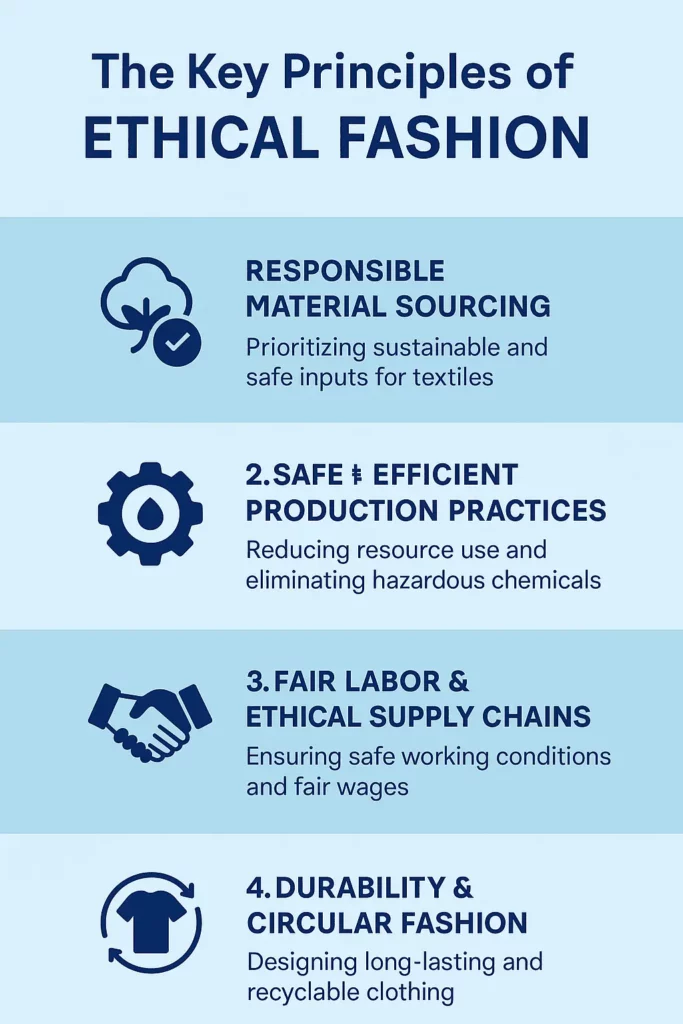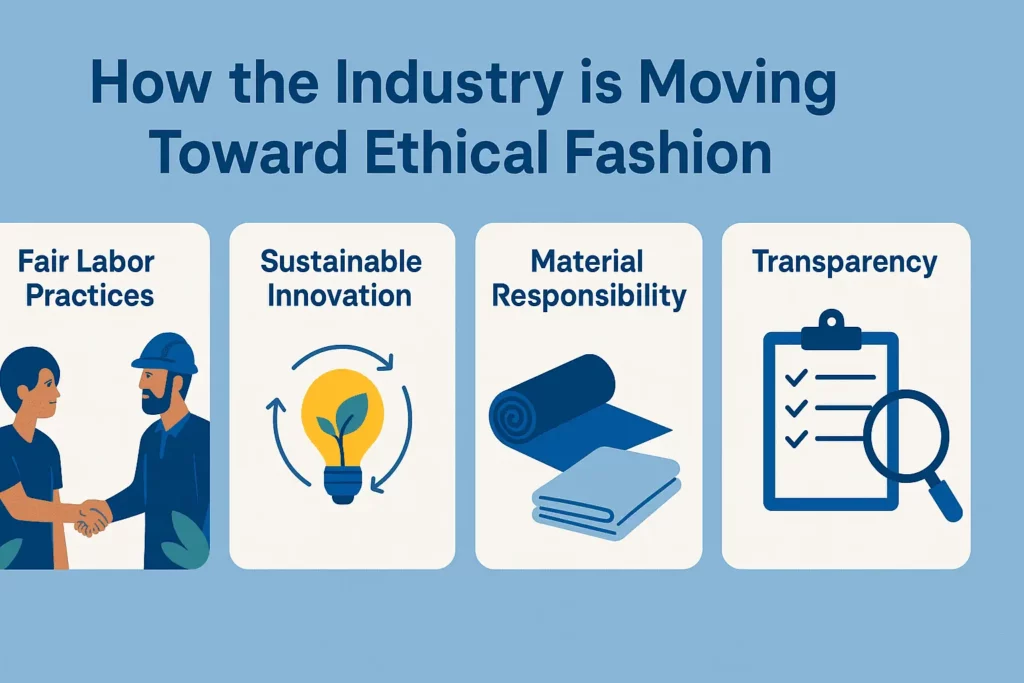
Ethical Fashion: A Guide to Safe, Sustainable, and Responsible Style
What is Ethical Fashion?
Ethical fashion is about making clothing in a way that protects both people and the planet. To protect people, ethical fashion focuses on ensuring that workers are treated fairly, that they work in safe environments and that their rights are protected. To protect the planet, ethical fashion ensures that materials are sourced responsibly, production not only doesn’t harm the environment but ideally improves it, and that the enjoyment of fashion doesn’t rely solely on consumption but also includes other circular options.
But as consumer awareness grows, so does the demand for greater transparency. Reports exposing toxic chemicals in clothing—such as PFAS, phthalates, lead, and cadmium—highlight serious risks to human health and the environment. Ethical fashion is therefore fashion that goes beyond “just” style—it’s fashion that considers the aspects of sustainability, accountability and safety.

The Role of bluesign in Ethical Fashion
For nearly 25 years, bluesign has been leading the clean chemistry movement, helping brands eliminate hazardous substances, optimize resource usage, and ensure textiles are safe for workers, consumers and the environment.
By working with over 800 system partners worldwide—including chemical suppliers, textile manufacturers, and global brands—bluesign is setting new benchmarks for safer, more responsible fashion.
Ethical Fashion vs. Fast Fashion: What’s the Difference?
Not all clothing is made in a responsible manner. Fast fashion prioritizes speed and cost, often leading to poor working conditions, environmental harm, and a lack of accountability. Ethical fashion, on the other hand, focuses on sustainability, transparency, and cleaner, safer production methods.
The Challenges of Fast Fashion
Fast fashion has transformed the way people buy and wear clothing. By offering cheap, trend-driven garments at an unprecedented speed, major retailers have fueled a culture of disposable fashion, where clothing is worn only a few times before being discarded. While this model makes fashion more accessible, if only in the short term, it also comes with serious social and environmental costs—ones that are becoming harder for brands to ignore.
Behind the scenes, the fashion industry is resource-intensive, chemically dependent, and often linked to poor labor practices. Fast fashion exacerbates these issues through their sheer scale and speed. Reports have exposed dangerous levels of toxic chemicals in mass-produced clothing, highlighting risks to workers, consumers, and ecosystems. Additionally, with more than 100 billion garments produced globally each year, textile waste has become an enormous environmental crisis.
But the winds of change have been blowing. As consumers become more informed, regulators enforce stricter environmental and due diligence laws, and brands seek more sustainable business models, the industry is being forced to address these challenges. Understanding the true cost of fashion is the first step toward a more responsible, ethical approach to clothing.
Here are some of the biggest issues tied to the fashion industry:
- Worker exploitation – Many garment workers endure unfair treatment and unsafe conditions.
- Toxic chemicals in textiles – Fast fashion often uses harmful dyes and finishes, leading to health risks for workers and consumers.
- Resource-heavy production – Excessive use of energy, water, raw materials and synthetic chemicals accelerates environmental damage.
- Short product lifespan – Low-quality materials lead to clothing that wears out quickly, creating waste and pollution.
- Overproduction – To achieve the lowest cost price per item, huge orders are placed, a large percentage of which end up incinerated or in landfilled without ever being worn.
How the Industry is Moving Toward Ethical Fashion
As consumer demand for transparency and sustainability grows, fashion brands, manufacturers, and suppliers are shifting towards more ethical practices. This transformation isn’t happening overnight, but key innovations and policy changes are paving the way for a safer, cleaner, and more responsible industry.
Ethical fashion challenges these issues by focusing on:
- Fair labor practices – Brands are committing fair treatment of workers and safe working environments.
- Sustainable production – Companies are investing in responsible production methods that are resource-efficient and/or minimize waste and emissions.
- Material innovation – Fabrics of both natural and synthetic origins can be created in safer and more sustainable ways.
- Circularity – Circular fabrics can be produced by using waste as its raw materials. Circular business models diversify and future-proof revenue streams by decoupling profit from production (e.g. rental, repair, resale).
How bluesign helps: Through clean chemistry and clean manufacturing, bluesign eliminates hazardous substances, reduces resource consumption, and ensures safer materials enter the market.

Key Principles of Ethical Fashion
1. Safer, More Sustainable Materials
Ethical fashion is about reducing harmful chemicals while optimizing the performance and durability of textiles.
Here’s how brands are improving material sourcing:
- Eliminating toxic chemicals, such as PFAS and phthalates, from the supply chain. This is particularly relevant for outdoor wear, which often relies on these “forever chemicals” for their DWR (Durable Water Repellant) coating. Fortunately, there are alternatives today for going PFAS-free without sacrificing performance. Learn more about PFAS and PFAS-free clothing here.
- Using recycled fibers (e.g., recycled polyester, nylon) to reduce the use of virgin materials. A particular exciting technology is the chemical recycling of synthetic fibers, as it does not have the quality issues of mechanical recycled fibers and can be infinitely recycled, making the fiber truly circular.
- Choosing bluesign Approved fabrics, which not only meet strict safety and environmental standards, but also promote supply chain transparency, a key step towards accountability.
2. Responsible Manufacturing & Chemical Management
Fashion should not come at the cost of worker health or environmental safety. Clean manufacturing means:
- Optimizing chemical use – Removing carcinogenic, mutagenic, and toxic-for-reproduction (CMR) substances.
- Reducing water and energy consumption – By implementing resource-efficient dyeing and finishing processes or by introducing new technologies, production can leave a lighter footprint on our planet.
- Partnering with suppliers who are bluesign System Partners – Ensuring compliance with industry-leading standards on both chemical management and occupational health and safety, protecting the workers in the value chain, consumers as well as our environment.
3. Transparency & Supply Chain Accountability
Consumers want to know where their clothes come from—and brands are responding by making supply chains more transparent. This is the key first step towards accountability within the value chain, where a brand’s actions have real impacts.
- Supply chain mapping – Creating verifiable digital records of the origins of an item from fibre to product. This traceability enables businesses to identify risks, mitigate them and offer remediation where necessary.
- Third-party verification – Certifications like bluesign ensure claims are backed by data and, by doing so, prevent greenwashing.
- Digital product passports – Once the data is available and verified, it can then be shared with the public by means of RFID and/or QR codes on clothing, enabling full transparency.
How bluesign leads transparency efforts: The bluesign system tracks and verifies every step of production, ensuring that only safe, responsible materials enter the supply chain.
How to Identify and Shop for Ethical Fashion
There’s no way around this: The most sustainable piece of clothing is always the one that is already in your wardrobe.
Engaging with fashion sustainably means looking at other ways to satisfy your fashion needs and wants before buying new. This means:
- Using what you have
- Borrowing
- Swapping
- Buying secondhand
- Making your own or upcycling what you have
- And, only if the options above have been exhausted, buying new
Should we buy new, we should try to spend with brands that prioritize sustainability. One way to ensure the products we buy were responsibly manufactured is by supporting bluesign System Partners, who follow strict environmental and safety criteria.
Shop from Brands Committed to Ethical Fashion
Here are some brands that have partnered with bluesign to produce high-quality, sustainable clothing:
- Patagonia – A leader in corporate responsibility, integrating bluesign-approved materials into its outdoor gear.
- Storm Creek – Dedicated to eco-friendly apparel, using recycled materials and bluesign-approved fabrics.
- Helly Hansen – Technical outerwear brand committed to clean chemistry and responsible sourcing.
- Mammut – Leading in high-performance outdoor gear with a focus on sustainability.
- Jack Wolfskin – Eco-conscious outdoor brand using bluesign-certified fabrics.
- Burton – A pioneer in sustainable snowboard gear, prioritizing safe and responsible materials.
- Osprey – High-quality backpack manufacturer ensuring traceable, responsible production.
- Thule – Outdoor gear company committed to clean, sustainable manufacturing.
Ethical Fashion Innovations & Industry Trends
As global governments tighten regulations on textile production, brands must adapt to new sustainability standards. The future of ethical fashion will be shaped by:
- Better chemical management – Eliminating PFAS, phthalates, and other harmful substances. Ensuring safe handling of chemicals by workers.
- Circular fashion – Introducing circular business models such as rental, repair and resale. Increasing recycling by building the infrastructure to collect and sort garments.
- Digital transparency – Strengthening supply chain traceability through digital tracking.
How bluesign is leading this transformation:
- Setting industry benchmarks for cleaner, safer textiles.
- Optimizing resource efficiency, reducing water, energy, and chemical waste.
- Empowering brands with actionable solutions to meet new sustainability demands.
Taking Action: How to Support Ethical Fashion
Consumers:
- Choose quality over quantity – Invest in durable, long-lasting clothing.
- Look for bluesign Approved products – They meet the highest safety and sustainability standards.
- Support brands with supply chain transparency – Check for certifications and verified sourcing practices.
Explore ethical fashion brands.
Brands:
- Improve sustainability efforts with proven, science-backed solutions.
- Partner with bluesign to eliminate hazardous substances from production while improving resource efficiency.
- Ensure compliance with global environmental standards and regulations.
Learn how to integrate bluesign into your supply chain.
The Future of Ethical Fashion
The fashion industry stands at a critical crossroads. For 25 years, bluesign has been driving change by empowering brands, manufacturers, and suppliers to adopt safer, more sustainable practices.
The future of fashion needs to go beyond just looking good—it’s about doing good while looking good. By prioritizing safe materials, ethical production, and real transparency, brands and consumers can drive meaningful change. With bluesign leading the way in clean chemistry and responsible manufacturing, a safer, more sustainable fashion industry isn’t just possible—it’s happening now.

Reviewed by Chu Wong
R&D and Strategy Expert, Sustainability – bluesign Academy
This article was reviewed by bluesign Academy experts for accuracy.

